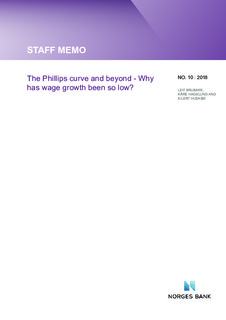| dc.contributor.author | Brubakk, Leif | |
| dc.contributor.author | Hagelund, Kåre | |
| dc.contributor.author | Husabø, Eilert | |
| dc.date.accessioned | 2018-12-12T08:44:28Z | |
| dc.date.available | 2018-12-12T08:44:28Z | |
| dc.date.issued | 2018 | |
| dc.identifier.isbn | 978-82-8379-057-3 | |
| dc.identifier.issn | 1504-2596 | |
| dc.identifier.uri | http://hdl.handle.net/11250/2577279 | |
| dc.description.abstract | In this paper, we estimate various dynamic wage equations for mainland Norway. Our starting point is a standard Phillips curve. We then expand on our baseline specification by adding explanatory variables suggested by economic theory. In our preferred specification, the labor share plays the role of an error correction term. This means that whenever the wage level is high relative to the value of productivity, there is a tendency for wage growth to slow down. We demonstrate that accounting for this level effect, which has also proven useful in earlier studies on Norwegian data, is particularly helpful in understanding the low wage growth in recent years. | nb_NO |
| dc.language.iso | eng | nb_NO |
| dc.publisher | Norges Bank | nb_NO |
| dc.relation.ispartofseries | Staff Memo;10/2018 | |
| dc.rights | Attribution-NonCommercial-NoDerivatives 4.0 Internasjonal | * |
| dc.rights.uri | http://creativecommons.org/licenses/by-nc-nd/4.0/deed.no | * |
| dc.title | The Phillips Curve and Beyond - Why Has Wage Growth Been so Low? | nb_NO |
| dc.type | Working paper | nb_NO |
| dc.description.version | publishedVersion | nb_NO |
| dc.subject.nsi | VDP::Samfunnsvitenskap: 200::Økonomi: 210 | nb_NO |
| dc.source.pagenumber | 22 | nb_NO |

